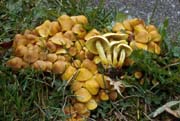
Paul Kroeger. March 31 2009
Trial Keys to purple to blackish spored
STROPHARIACEAE
of British Columbia, Canada
Copyright © Paul Kroeger 2009
Family Strophariaceae (Agaricales)
Subfamily Stropharioideae sensu Singer 1986
| Genera: | Hypholoma (= Naematoloma) |
| Melanotus | |
| Mythicomyces | |
| Psilocybe | |
| Stropharia |
Key to the Genera of Strophariaceae
References for Strophariaceae Keys
Pacific Northwest Taxa excluded from Keys
The Strophariaceae is a family of gilled mushrooms with dark spores characterized by having the following characteristics: Filamentous cap cuticle, attached gills, brown to purple brown smooth spores with germ pores, and regular gill trama. Development is monovelangiocarpic.
The Strophariaceae are traditionally divided into two subfamilies based on spore colour:
Stropharioideae: with deep lilac, fuscous or purple brown to blackish brown spores. Treated in these keys.
Pholiotoideae: with cinnamon brown, rusty brown, ochraceous or dull brown spores. Not treated in these keys. See Pacific Northwest Key Council Pholiota key by Kit Scates 1981 (2003).
Development of the fruit body is monovelangiocarpic, which is to say the primordial structure is protected by a veil covering the outside of the fruit body, without an inner veil. Veil remnants may be conspicuous and persistent forming a large membranous or floccose annulus on the stem and scales on the cap surface or hanging patches on the cap edge, or remnants may be fleeting and best seen in young specimens, often filamentous or cortinate remnants form sparse ring zones on the stem or leave traces on the cap margin and edge.
The cap surface is composed of thin-walled, filamentous, hyaline walled but often pigment encrusted septate hyphae with clamp connections, frequently imbedded in a gelatinous layer, in some species and groups of species the surface hyphae are bundled and somewhat erect to form hairy scales, or tangled to create a plush surface over a repent filamentous background layer. In some there is also a subcellular layer of shortened and inflated hyphae beneath a layer of repent strands.
The gills are sinuate or adnexed to adnate, or adnate and slightly decurrent onto stipe, often the gill edges are fringed and pale or whitish. The tissue in the gills is regular, being composed of more or less parallel filamentous thin walled hyphae with septae and clamp connections.
Differentiated sterile cells or cheilocystidia are present and often abundant on the gill edges. Cystidia on the gill faces called pleurocystidia are either absent or scattered to abundant. Cystidia are often in the form of chrysocystidia, which are specialized and usually large-bodied cystidia containing irregular bodies of yellowish material in alkaline solutions such as KOH or NaOH.
Spores are pigmented brown to rusty brown to purplish brown or lilac brown to blackish in deposit, smooth or rarely slightly roughened, the spore wall is thick, deeply pigmented and differentiated into two layers, the endosporium and episporium. The episporium or outer layer is discontinuous at the top of the spore (the end of spore furthest from the attachment to the basidium, the distal end.), this forms a more or less distinct "germ pore" and sometimes the end of the spore appears truncate or chopped off, at other times there is a mere thinning of the spore wall in optical section. The proximal end of the spore has a distinct hilar appendage or apiculus, the bump or snout by which the spore was attached to sterigmata of the basidium.
1a. Spores brown to dull brown; lacking dark grayish, violaceus or purple brown to purplish or violaceous black colour.
Pholiota sensu lato. Not treated in these keys
1b. Spores dark grayish, violaceous or purple brown to purplish or blackish in colour.
2a. Small pleurotoid mushrooms, stem eccentric or lateral, reduced to much shorter than cap width, often strongly curved, caps asymmetric, kidney to fan shape and often attached to substrate.
2b. Stem centrally attached and not reduced, cap more or less symmetric.
3a. Both stem and cap covered with a slime veil and glutinous to viscid, appearing varnished when dry, tall in stature with stem usually longer than twice cap width, stem base often radicating or tapering deep into substrate.
3b. Slime veil lacking on stem, stem dry and not appearing varnished.
4a. Fleshy mostly robust large mushrooms with well developed membranous or floccose ring on stem or cap edge, caps convex fleshy and not translucent striate, often rather brightly coloured., white, yellow orange red or blue to green. On ground, stem base often with copious thick white strands or rhizomorphs spreading into substrate. Microscopic; chrysocystidia and acanthocytes present in most.
4b. Thin fleshed medium or small mushrooms lacking well developed ring on stem, veil usually filamentous, leaving fibrillose or cortinate remnants, a few have small, viscid, translucent striate and brown.
5a. Caps usually not viscid or striate, veil filamentous or cortinate and leaving few remnants, cap colour often yellowish or orange brown to pale brown or greenish, tending to become slightly radially wrinkled when drying. Microscopic: surface filamentous, below this subcellular with a distinct layer of swollen short cells, chrysocystidia present, acanthocytes absent.
Hypholoma (= Naematoloma)
5b. With gelatinous translucent cap surface when fresh and moist, surface often with a thick gelatinous pellicle or layer which can be peeled away, when fresh transparent and gills visible through cap flesh as translucent striae or radiating lines, when drying fading to opaque and whitish. Veil remnants are variable. Mostly small brown species with thin cap flesh. Several stain blue with handling or in age. Microscopic: chrysocystidia absent, beneath gelatinous filamentous surface also filamentous.
Some exceptions to key characters in this treatment:
Hypholoma myosotis has a glutinous cap surface, spores often rusty brown.
Psilocybe fimetaria possesses a membranous annulus.
Psilocybe stuntzii possesses a membranous annulus.
Stropharia albivelata has a brown spore deposit without distinct purplish colour.
Stropharia aurantiaca no membranous ring on stem, cap radially wrinkled when drying.
Stropharia squamosa lacks chrysocystidia, now considered a Psilocybe.
Stropharia squamosa var. thrausta lacks chrysocystidia, now considered a Psilocybe.
Stropharia umbonatescens lacks chrysocystidia, now considered a Psilocybe.
1a. Growing on wood, directly on logs and stumps or on buried wood or in conifer litter.
1b. Growing in wetland soils often with mosses or monocots, or in cultivated soils in landscaped areas. Not on wood.
| 2a. Gills at first sulfur yellow to greenish yellow distinctly green in maturity, crowded and shallow, cap yellow often with orange brown over center, stem sulfur yellow to greenish yellow becoming reddish brown toward base. Taste metallic bitter. Usually densely caespitose or bunched to clustered on logs and stumps, or on buried wood. Very common. |
© Steve Trudell
|
Hypholoma fasciculare
2b. Gills are whitish to gray at first, cap and stem lacking yellow.
| 3a. Robust mushrooms growing caespitose to clustered on conifer wood, on logs and stumps. Cap 3-5 (7) cm. wide stem 5-7 cm. long by 4-8 mm. thick. Gills white to grayish white young becoming gray. Stem silky fibrillose often curved, pallid becoming rusty brown from base upwards. |
© Boleslaw Kuznik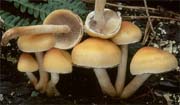
|
Hypholoma capnoides
| 3b. Small slender mushrooms growing on sawdust or woody debris and conifer litter on ground, more rarely on large wood pieces. Cap 1-3.5 cm. wide stem 6-10 cm. long by 2-5 mm. thick. Cap usually remaining conic to convex and not opening further to become flat. Stem usually straight and slender, covered by dense grayish white to silvery fibrillose layer and appearing often finely banded or diagonally streaked below a ring zone of veil fibrils. Common on wood chips and debris on logging roads and in logging debris. |
© Michael Beug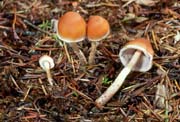
|
Hypholoma dispersum
| 4a. Mushroom with underground sclerotium or tuber that is brown and lobed very much like walnut meat. Found in cultivated horticultural gardens and apparently native to Australia. Stem attached directly to sclerotium if shallow or arising from deeply buried sclerotia by a long tapering root-like pseudorrhiza, sometimes one sclerotium can produce several mushrooms. Cap orange brown in center with light yellow orange near edge, stem similar in colour to cap, tapering upward and swollen at soil level, veil forming a fibrillose to cobwebby white ring zone. |
© Paul Kroeger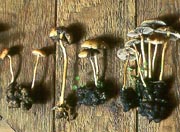
|
Hypholoma tuberosum
4b. Not with underground sclerotium, growing in wet areas in mucky soils, mosses or decaying wetland plant remains.
| 5a. Cap viscid to glutinous, bronze brown, olive bronze or olive brown, not striate or only slightly so in age. Tall stately mushrooms, cap 1.5–4 cm. stem 6-15 cm. long by 3-7 mm. thick, with a rigid stem that is pallid to olivaceous with diagonal broken bands of cap coloured veil forming a "snake skin" pattern, a faint ring zone is near the top. Gills widely spaced and whitish at first becoming olivaceous then brown. Gregarious in wet humus and mucky soils at bog edges. |
© Paul Kroeger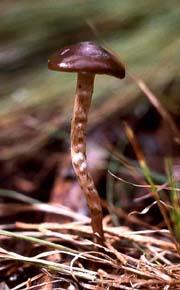
|
Hypholoma myosotis
Also known as Pholiota myosotis because the spores are dull rusty brown.
5b. Cap not viscid or glutinous, dry or at most just slightly greasy when moist.
6a. Cap with predominantly yellow colouring, not becoming brown with maturity, pale to medium yellow with olive gray or greenish toward margin in age, convex becoming flat, thin and often wavy and radially wrinkled. Very slender, tall and fragile mushrooms with stipe at least 4 times longer than cap is wide, cap 0.5-2 cm. wide, stem 4-10cm. tall by 1.5-2.5 mm. thick. In bogs and wet lands usually in Sphagnum or in Polytrichum mosses or litter in muck. Spores 9-11.5 (12.5) μ by 5.5-7 μ smooth
Hypholoma elongatum
A similar species recorded for BC is Hypholoma udum, a more robust mushroom found in Sphagnum in peat bogs. Young caps with ochraceous center and straw yellow margin fading to yellowish or ochraceous buff in age, cap 1.0-2.5 cm. stem 4-8 cm. by 2-4 mm. thick. Spores 14-18 μ by 5-7 (9) μ, slightly roughened under oil immersion.
6b. Cap predominantly brown, if with yellow colouring this is only near margin.
7a. Cap starting out yellow but soon becoming reddish brown or date brown or tawny over most, cap margin remaining yellowish, gills start yellow and become yellowish olive then purplish-olive brown. Microscopic: spores 9-12 μ by 6-7 μ.
Hypholoma ericaeoides
7b. Cap brown from the beginning, rusty brown to tawny or ochraceous, gills starting out gray or dirty whitish without yellow colour, becoming dark gray to purplish brown. Microscopic: spores 7-10μ by 4-5μ.
Hypholoma subericaeum
A very similar species not yet known in BC but which is expected to occur is Hypholoma ericaeum with gills becoming blackish with conspicuously white fringed edges and spores 12-15 μ by 7-8 μ.
1a. Small species, rarely up to 1 cm. diameter, growing on dead monocots; sedges, rushes and grasses or on herbaceous stems.
| 1b. More robust, and growing on wood and bark of shrubs and trees and on a variety of man-made materials such as fabrics, ropes, furniture, plant fiber mats, often on underside of materials or on vertical surfaces. caps 0.8-1.8 (3) cm. diameter, starting hemispherical expanding to convex, broadly convex or flat, inequal in shape to kidney shape with one side attached to substrate, surface dry, almost smooth to matted tomentose to felted, becoming somewhat rubbery in texture, not striate, gills close to moderately spaced, cinnamon to smoky cinnamon, to smoky brown or vinaceous grayish brown, white fringed at edge, stem short eccentric to vestigial, 0.5-1.5 cm. long by 1-5 mm. thick, "U" shaped and brown to dark brown, covered with whitish to pale brown tomentum, narrowing toward base at attachment to substrate which has a white mycelial mat. |
© Paul Kroeger
|
Melanotus horizontalis
Previously western North American material was referred to as Melanotus textilis.
2a. Very small mushrooms on dead foliage of sedges (Carex, Scirpus; Cyperaceae) and rushes (Juncus; Juncaceae) in marsh habitats. Caps 2–6 mm., gelatinous beneath a thin hoary coat at first, soon bald, translucent striate, sienna coloured centrally paler toward margin sometimes with pinkish tint, gills pale clay becoming tinted umber or violaceous umber with rather thick paler edges, stem 1-3 mm. by 0.2-0.5 mm. thick. Microscopic: spores 5.5-7.5 μ by 3-4.5 μ, broadly ovoid to ellipsoid in face view, narrowly ovoid in side view.
Melanotus caricicola
2b. Small mushrooms most often on grasses but also on sedges and herbaceous plant remains. Caps 4-8 (10) mm. wide, cinnamon to grayish brown, surface dry and not translucent striate. Gills pale cinnamon, stem 1-3 mm. by 0.5 mm. thick. Microscopic: spores 5-6 (7) μ by 2.7-3.5 μ, elliptic in face view, narrow elliptic side view. Not yet recorded for British Columbia but likely to occur.
Melanotus phillipsii
1a. Stipe base and other surfaces and flesh staining blue when damaged, bruised or in age. Section Caerulescentes.
1b. Mushrooms not showing blue staining.
2a. Veil forming a distinct and persistent membranous annulus or ring on stem.
2b. Veil not forming a membranous ring but may leave distinct bands of fibrils.
3a. Cap conical-convex to umbonate with distinct nipple or papilla and translucent striate only at the edge. Stem whitish at first. Rare in grazed pasture in old dung or manured soils and lawns. Microscopic: spores 11-14 μ by 6.5-8.5 μ, subellipsoid to ellipsoid.
Psilocybe fimetaria
| 3b. Cap convex or domed to flat without papilla or nipple, surface a viscid thick gelatinous pellicle or layer which can be peeled away, when fresh transparent and gills visible through cap flesh as translucent striae or radiating lines, when drying fading to opaque and whitish., stem yellowish brown to brown, with a thin membranous, often bluish ring. Common and sometimes abundant in lawns, bark mulch and mulched soils of gardens, especially in recently established landscaping. Microscopic: spores 9.3-10.4 μ by 6.0-7.1 μ by 5.5-6.6 μ, subrhomboid in face view subellipsoid in side view. |
© Michael Beug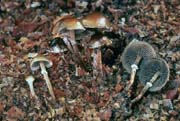
|
Psilocybe stuntzii
4a. Bluing mushrooms mycenoid in stature. Tall stature with slender stem longer than 2 or 3 times the cap width, cap at least as high as wide when young and expanding to convex but not flattening.
4b. Bluing mushrooms collybioid in stature. Stem not particularly thin and slender, length not exceeding 2-3 times the cap width. Cap convex expanding to broadly domed or flat and wider than tall.
| 5a. Growing in woody substrates, especially in wood chips and debris of logging roads, in conifer forest margins on twigs and twiggy duff, sometimes on rotting logs, also in landscaping with wood based mulches.. Cap conical to bell shaped or umbonate without a sharp nipple or papilla in center, surface a thick gelatinous pellicle or layer which can be peeled away, when fresh transparent and gills visible through cap flesh as translucent striae or radiating lines, when drying fading to opaque and whitish. Microscopic: spores 9.3-11 (12) μ by 5-6 μ, ellipsoid to subovoid. |
© Kit Scates Barnhart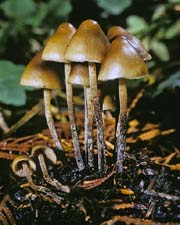
|
Psilocybe pelliculosa
5b. Growing in grazed pasture, lawn or other grassy habitat, wet meadows with rushes and sedges, usually growing from dead material such as roots, stems and leaves of grasses and other monocots, or directly on dung.
| 6a. Cap with a pronounced papilla or fleshy nipple in center, sharply conical young cap, remaining conical and pointy and cap height usually equal to width when opened fully, translucent striate at cap margin only, margin remains incurved and is often crimped or puckered inwards and almost clasping the stem and dark fringed by spores, stem white and often slightly wavy, veil remnants may be evident when young as a faint band of fine strands darkened by spores but soon disappearing, base of stem especially showing bluing, growing from old roots and bases of grasses and monocots, not directly on dung. Microscopic: spores 12-14 (16) μ by 7-8 μ by 4.8-5.4 μ, subellipsoid to ellipsoid. |
© Michael Beug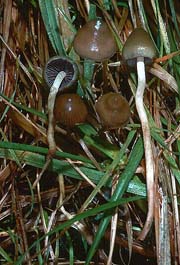
|
Psilocybe semilanceata
6b. Cap conical but with a blunt or rounded center, no distinct nipple or fleshy point, growth on dung or in grasses and other monocots.
| 7a. Habitat on dung or in grazed or manured pasture and lawn. Very much like P. semilanceata but with blunt cap and heavy fibrillose veil zone that persists with age. Microscopic: spores 11-12 μ by 6.6-7.7 μ, subellipsoid in face view, irregular subelliptic in side view |
Psilocybe subfimetaria
7b. Habitat in tufts of grasses and sedges in wet pasture and grassy habitats, not on dung though may be in grazed pasture. Like P. semilanceata but with an umbonate domed or blunt cap, expanding to convex with an umbo, translucent striate over most of cap when fresh then and lacking a persistent fibrillose veil. Microscopic: spores 10-13 μ by 5.5-7 μ, ellipsoid to oblong.
Psilocybe strictipes
Previously also known as Psilocybe callosa.
| 8a. Collybioid mushrooms with somewhat orange brown or caramel hygrophanous caps that start out conical convex and soon expand to become flat or with edges uplifted making cap concave viewed from above, cap margin usually wavy and undulating. Gills when young tan to cinnamon brown, maturing to deep smoky brown with white edges. When young with a snow white cobwebby veil connecting cap edge to stem that disappears during expansion, leaving at most a faint zone of spore-darkened fibrils on stem. Stem often slightly curved below with white bristling hairs about the base which is somewhat expanded, surface white and smooth over most and strongly bluing when damaged or with age. Habitat on wood, wood chips and soils with much wood chip or wood shavings contained, lawns with woody material beneath, waste places with brambles, alders etc, on twigs and woody debris. |
© Fred Stevens (MykoWeb).jpg) |
Psilocybe cyanescens
| A very closely related species, Psilocybe azurescens, differs only in cap shape, evenly conic to conical convex with a pointed umbo or papilla. Known to be cultivated outdoors in BC, native to Astoria, Oregon. |
© Paul Kroeger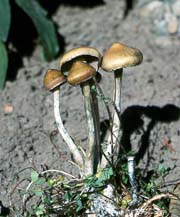
|
Psilocybe azurescens
8b. Mushroom caps dark brown or dark olive brown and not usually expanding to flat, not uplifting at sides to become concave topped.
| 9a. Caps bluntly conic convex when young with inrolled irregular margin, expanding to convex with a broad umbo or broadly domed, with margin crimped inward and wavy undulating rather like a bottle-cap edge, when fresh and moist conspicuously translucent striate, hygrophanating to white with bronze or copper colour over center, veil faint fibrillose in very young and soon disappearing. Gills shallow and strikingly gray when young. Stipe often irregularly bent or crooked with surface irregular and often rather crinkled and twisted, lacking zone of veil fibrils. Habitat on bark chips or peat moss and in landscaping soils and lawns, especially in institutional settings, coastal. Not reported in the last decade, may be extirpated? |
© Michael Beug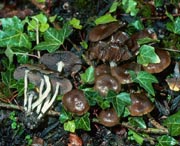
|
Psilocybe baeocystis
| 9b. Caps conic to convex young usually without umbo, expanding to broadly convex or flat, cap margin evenly incurved not wavy or crimped, cap more or less symmetric, not translucent striate except faintly on edge when fresh and moist, hygrophanating to tan or light brown, veil in young connecting cap edge to stem with dense gray to blue gray fibrils and remaining on upper stem as a band of gray to bluish fibrils. Stem straight and regular, coated with silvery gray to bluish gray fine fibrils. Habitat attached to plant roots in floodplain of mountain rivers, also urban in landscaping with Rhododendrons. |
© Paul Kroeger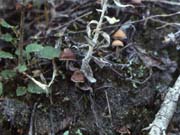
|
Psilocybe cyanofibrillosa
10a. Non bluing species growing on dung or in heavily manured soils.
10b. Non bluing species growing in other habitats, not associated with dung.
| 11a. Mycenoid stature, cap higher than wide and acutely conic to conical campanulate, stem longer than twice height of cap, cap .2-.6 cm., stem 1-2 (4) cm. by .5-2 mm. thick, habitat on deer, elk, marmot, and perhaps moose dung, also reported elsewhere from dung of domestic animals such as sheep, cattle and horse. Rare. Microscopic: spores narrow elliptic 12-16 μ by 5-8 μ. |
© Fred M Rhoades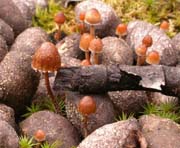
|
Psilocybe angustispora
11b. Stature not mycenoid, cap semiglobose to broadly bell shaped becoming convex to broadly convex or flat and wider than high, stem not much longer than cap is wide.
12a. Cap fresh brown to dark brown or reddish brown and margin translucent striate halfway to center, veil may be present as small fragments on margin but not leaving a distinct ring zone on stem.
12b. Cap fresh grayish brown, olive gray or olive brown or pale brown to ochraceous, opaque over most not translucent striate or striate only near edge, distinct ring zone left on stem.
| 13a. Cap smooth and viscid young, shiny when drying out and hygrophanated, expanding to broadly convex or almost flat. Microscopic: spores 10-12 μ by 7-9 μ, faintly hexagonal or subrhomboid in face view. |
© Paul Kroeger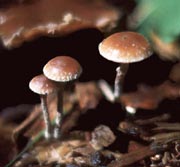
|
Psilocybe coprophila
13b. Cap surface minutely bumpy or irregular and rough, dull when drying out and hygrophanating or fading rather spottily and appearing granular in the process, not expanding much more than hemispheric. Microscopic: Spores 14-18 (20) μ by 7-9 (10) μ, ellipsoid in face view not at all faintly rhomboid or hexagonal.
Psilocybe subcoprophila
| 14a. Cap semiglobose young expanding to hemispheric to convex not tending to flatten further, cap margin pale in colour, not striate, with scattered small fibrillose patches near edge but not forming a hanging fringe. Stem with a fibrillose ring zone in lower portion. Microscopic: spores 11-13 μ by 7-9 μ. |
© Buck McAdoo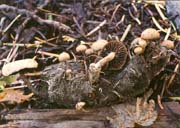
|
Psilocybe merdaria
14b. Cap convex to broadly convex or almost flat, sometimes with a small umbo, when fresh margin opaque to translucent striate near edge, young edges festooned with hanging patches of fibrillose veil. Microscopic: spores 13-16 μ by 7.5-9 μ.
Psilocybe moelleri
| 15a. Mushrooms growing in mucky soil and among mosses of perennially wet areas such as streambeds and bog ponds, mycenoid in stature, cap conic to campanulate or umbonate to convex, smooth and polished looking, orange brown or ochraceous, margin incurved and translucent striate, gills whitish at first becoming pale gray tan to hazel, stem usually twice or more as long as cap is wide, reddish brown in lower portion and blackening with surface smooth and polished, faintly pruinose at stem top, tough or horny, base covered with tawny hairs. Microscopic: Cystidia on gill edges and faces brownish thick walled and crystal-capped, spores rough walled, 6-8.5 μ by 4-5.5 μ, pale grayish brown. |
© Paul Kroeger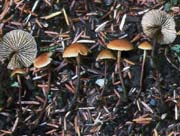
|
Mythicomyces corneipes
Previously known as Psilocybe corneipes. The macroscopically almost identical Stagnicola perplexa differs in lacking thick walled cystidia and having smooth smaller spores 4.9-6.0 μ by 3.0-3.8 (4.5) μ.
15b. Not as above.
16a. Mushrooms growing in sand, in coastal dunes with dune grass Ammophila and Carex macrocephala or in dry sandy soil of arid bunchgrass and antelope-brush steppes of the southern interior. Cap convex to umbonate expanding to almost flat, not viscid, ochraceous brown to pale brown fading to straw colour, margin sometimes with white veil remnants. Stem extending in a short root-like base into sand and covered with white mycelium. Microscopic: spores (11) 12-16.5 (18.7) μ by 8.2-9.3 μ by 7-8.2 μ, ellipsoid or subellipsoid in front and side view, thick walled with a broad germ pore.
Psilocybe sabulosa
Resembles and occurs with Agrocybe arenaria or Agrocybe subpediades, sand dwelling taxa often referred to Agrocybe pediades sensu lato, but lacks their rounded bulb-like base or finger-like extensions of clumped sand, and has purple brown white fringed gills and purple brown spore deposit. Very rarely collected.
16b. Not as above.
17a. Growing in mosses.
17b. Habitat different; wood, herbaceous plant remains or landscaping soil rich in organic material.
| 18a. In haircap mosses (Polytrichum) over sand and rock outcrops or other well drained sites. Small mushrooms, cap 0.5-1.5 cm. wide stem 1.5-4.0 cm. long by 1-2 mm. thick, cap dark red brown viscid and translucent striate over most when fresh, fading and hygrophanating to opaque pale brown or ochraceous buff, semiglobate at first becoming convex to broadly convex sometimes with a slight umbo. Very common and widespread and frequent in high elevation and boreal areas. |
© Michael Beug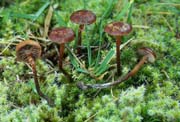
|
Psilocybe montana
| 18b. In Sphagnum in bogs. Fairly robust mushrooms, cap 2-4 cm. wide and stem 8-18 cm long by 4-5 mm. thick, cap very dark brown, reddish brown to black-brown, translucent striate only near the cap edge, fading or hygrophanating to brown to ochraceous buff or pale reddish-brown, convex often with a pronounced central nipple or papilla, expanding to broadly convex to almost flat. Rare, found in sphagnum bogs with deep peat formation and often growing with bog cranberry, sundews (Drosera) and Kalmia. |
© Paul Kroeger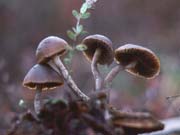
|
Psilocybe atrobrunnea
| 19a. Small mushrooms in newly established landscaping with rich soil mixtures. Caps convex with inrolled margin when young, expanding to flat and often with a central depression and margins somewhat uplifted, veil rusty brown to brown coarse fibrils connecting cap edge to stem, cap surface covered with a thin layer of fine pale brownish to gray fibrils that have been aptly described as resembling a coating of dust on a mahogany table top, not viscid or shiny but dull or mat, colour dark brown to dark reddish brown, fading or hygrophanating unevenly with center and margin often remaining darker thus creating a bull’s eye pattern of different colour concentric bands. |
© Paul Kroeger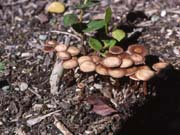
|
Psilocybe apelliculosa
19b. Habitat not as above, growing on plant remains, wood, herbaceous plant debris, grasses etc.
20a. Fairly robust mushrooms growing on necrotic or decaying leaves and rhizomes of sedges, esp. Schoenoplectis americanus (=Scirpus olneyi ss. Hitchcock & Cronquist), caps 2.5-4.0 cm. stems 3.5-5.0 cm. long by 4-7 mm. thick. Caps semiglobose to convex with inrolled margin, expanding with age to broadly convex with a broad umbo to almost flat but margin remaining incurved. Colour rich ochraceous brown to orange brown, surface moist not viscid, margin translucent striate with fine white flecks of veil remnants. Gills adnexed or narrowing toward stem, pale grayish or gray brown becoming dark gray brown, edges paler, gray. Stems with a ring zone of veil fibrils in upper portion, below which surface is coated with fine whitish fibrils, above ring zone is smooth to faintly pruinose. Microscopic: Spores (7) 8-9 (11) μ x (4) 5-6 μ x 4-5 μ. Thus far only known from Meager Creek Hotsprings but should be sought in sedges and other monocots of marshes elsewhere. Closely resembles Hypholoma subericaeum but differs in microscopic characters (lack of chrysocystidia and of subcellular subpellis) and in being less fragile.
[Psilocybe sp. Meager Cr. #1] PK1196, 1240, 1241, 1248.
20b. Smaller mushrooms, cap under 2.5 cm. wide. Stem under 4 mm. thick.
21a. Caps viscid with a gelatinous pellicle that usually peels easily.
21b. Caps not viscid, merely moist to subviscid and lacking a distinct gelatinous pellicle that peels, cap colours dark, rich brown, reddish brown to dark ochraceous brown, gills as dark as cap and maturing much darker, stems brown to reddish or ochre brown.
22a. Caps translucent striate only near edge, flesh of most of cap is thick so that gills are not visible through top even when wet.
| 22b. Caps translucent striate over all but disc, margin lacking veil remnants or with faint traces only when young and soon bare, growing attached to dead grass parts. Caps pale or drab brown, sometimes clay colour or grayish tan, gills at first pale grayish tan, becoming pale brown to slightly purplish brown or grayish brown with edges similar in colour, stem whitish to pale grayish or brownish near base brown with thin coating of white to tan fibrils. Habitat on dead roots and stems and leaves of grasses and other monocots such as rushes and sedges, usually clinging strongly to the substrate. Common in old lawns with much thatch and in meadows and pastures. Microscopic: spores 7.5-10 μ by 4.5-5.5 μ. Cheilocystidia 18-38 μ long, 5-8 μ wide. |
© Michael Beug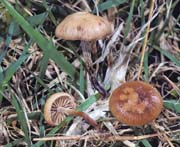
|
Psilocybe inquilina
23a. Caps when very young covered with veil which persists as scattered scales or patches on cap margin or hanging from edge and often leaving a ring zone on the stem.
23b. Caps have only the faintest traces of veil at the very edge even when young, these traces soon disappearing and not leaving a ring zone on stem. Colour reddish brown to cinnamon brown, viscid hygrophanous becoming straw colour or creamy buff often whitish toward margin. Gills pale grayish brown to purple brown or chocolate colour with white fringed edges. Stem usually about twice as long as cap width, densely coated with fine whitish to silvery grey fibrils but without ring zone, often slightly flexuous or wavy. Habitat on woody debris and leaves and forest litter. Microscopic: spores distinctly rhomboid in face view, elliptical to elliptic amygdaliform (almond shape) in side view. 5.5-8 μ long by 4.5-5 μ wide by 3.5-4.5 μ deep,
Psilocybe phyllogena
Also know as Psilocybe rhombispora due to its distinct spore shape.
| 24a. Young developing mushrooms with white floccose or wooly fibrillose veil coating cap margin and stem surface below a wooly fibrillose ring zone, persisting as small white scales scattered at cap margin. Mushrooms short and squat in stature and often wider than tall, growing scattered to gregarious. Caps grayish brown to dingy brown fading to pale yellowish tan, margin not striate and festooned with patches of white fibrillose veil remnants, gills pale brown to reddish brown, edges white fringed, stem brownish with a white coating of fibrils and often with a ring zone of white scales of fibrillose veil remnants. Growing in wood chips, sawdust, coarse herbaceous debris and grasses and other monocots. Microscopic: spores 5.5-6.6 μ by 4.25-5.4 μ. Cheilocystidia 25-45 μ long by 3-6 μ wide. |
© Paul Kroeger
|
Psilocybe crobula
24b. Young veil coating of tan to gray fibrils, cap soon bare but edge with remnants as cobwebby brownish to gray hanging traces, stem shaggy with brownish, gray or silvery fibrillose veil remnants and a distict ring zone of fibrils. Mushrooms tall, stem often wavy 2-3 times the cap width and noticeably tapered downward, often growing in caespitose clumps. Microscopic: spores 6.6-7.5 μ long by 4.4-5.0 μ wide, cheilocystidia 16-28 μ long by 4-7 μ wide.
Psilocybe physaloides
This is Psilocybe caespitosa of Murrill.
| 25a. Cap margin translucent striate, not incurved, edge with thin white veil remnants, gills close to moderately spaced, brown to dark umber, edges whitish to pale fringed, stems brown, pale brown to brown in upper portion to very dark brown to blackish near base, lower stem with sparse brownish-gray to whitish fibrils. Habitat on conifer wood chips and debris, apparently also on herbaceous plant remains. |
© Fred Stevens (MykoWeb).jpg)
|
Psilocybe subviscida
25b. Cap margin not striate or only very faintly striate near edge, strongly incurved when young and remaining incurved in maturity, young cap edges with coarse ochraceous to pale brown fibrillose veil remnants, gills close to crowded, dark brown to dark orange brown or dark reddish brown with edges pale brown and serrate fringed or jagged, stem dark orange brown to reddish orange brown, dark fibrillose surface, upper stem lighter, no ring zone evident. Habitat on decaying sedges and other monocots, found at Meager Creek Hotsprings.
[Psilocybe sp. Meager Cr. #2] PK1173 and 1190
1a. Veil present as a slimy or viscid sheath over the stem surface and often with a membranous annulus high up on the stem above which surface is dry, in dry conditions the stem surface below ring zone appears shiny and varnished, stature tall and slender, stem often more than twice as long as cap is wide and usually under 5 mm. thick.
1b. Veil present as floccose or membranous remnants on stem and/or cap, stem without slime sheath dry not viscid, though slimy capped species may have slime washed onto stem in rainy weather, but these have thicker and less elongate stems than the above.
2a. Growing in dung or manured soil, mostly associated with livestock, also wild ungulates. Microscopic; spores large 15-20 μ long.
2b. In forest duff, base of stipe radicating i.e. extending deep into the substrate. Microscopic; spores medium, less than 15 μ long
| 3a. Cap globose initially becoming semiglobose to hemispherical or convex, straw coloured or yellowish cream, slightly ochre tinted in age. No odour or mild. Microscopic; basidia four-spored. Chrysocystidia present. |
© Boleslaw Kuznik (MykoWeb).jpg)
|
Stropharia semiglobata
| 3b. Cap somewhat conical convex or campanulate to convex with a small umbo, ochre brown or dark buff young often with grayish tones becoming ochraceous buff. Odour strong rather like corn silk with slight ammonia. Microscopic; basidia mostly two spored, chrysocystidia absent. |
© Kit Scates Barnhart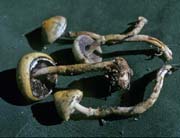
|
Stropharia umbonatescens
Apparently the same as Stropharia luteonitens, also known as Psilocybe luteonitens due to lack of chrysocystidia.
| 4a. Cap and stem straw colour or yellowish cream, cap obtusely conic becoming convex to plane. Stipe deeply radicating and coated with a gelatinous sheath, above a fibrillose veil zone high up the stem surface is pruinose and yellowish. Under spruce in fall. Microscopic; spores 8-10 μ long. Rare, not yet recorded for BC but expected. |
© Ben Woo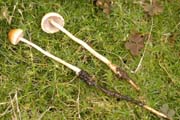
|
Stropharia semigloboides
| 4b. Cap and stem amber brown young, margin fading with age to chamois or amber buff with center remaining amber, stem white above, viscid in lower two thirds with diagonal banding of veil and honey yellow. Under spruce in the spring. Microscopic; spores 10-12.5 μ.. Rare, not yet recorded for BC but expected. |
© Paul Kroeger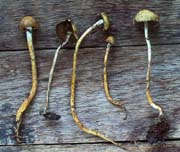
|
Stropharia silvatica
| 5a. Cap and stem dry, covered with dry fibrillose scales, cap brown, stem whitish with brownish scales, annulus wooly fibrillose submembranous, stature short and squat. In twiggy duff and leaf litter under deciduous trees in woods. Rare. Microscopic; has clamps, spores 6-7 by 4-4.5 μ with small germ pore, chrysocystidia present and with acanthocytes in basal mycelium. |
© Ben Woo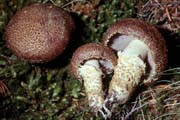 |
Stropharia kauffmanii
Agaricus subrufescens has been misidentified as this species, but has stem separating easily from cap and no chrysocystidia, germ pore or acanthocytes.
5b. Cap slippery to viscid or glutinous when moist, smooth beneath veil remnants.
6a. Cap and stem with distinct green to bluish colours.
6b. Cap and stem lacking green or blue colours.
| 7a. Stature slender and base of stem fragile becoming soft and easily breaking, cap 8-20 mm. stem less than 5 mm. thick. Habitat in wetlands especially on decaying grasses, rushes and sedges in marshes. Cap sky blue to greenish blue edged with scattered fine white floccose scales on margin at first, fading to pale bluish or greenish gray. Uncommon. |
© Ben Woo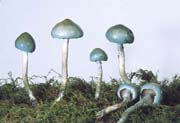
|
Stropharia pseudocyanea
Also known as Stropharia albocyanea and Pholiota subcaerulea.
7b. Stature more robust, stem firm not particularly fragile or breaking easily, cap 20-80 mm diameter, stem 3-11 cm long by 3 –12 mm thick.
| 8a. Cap bluish green with white floccose scales scattered over cap when young and remaining on margin, gills pale at first becoming purplish brown, smoky brown to blackish brown with white fringed edges. Stem bluish green, veil forming a floccose to membranous ring on stem that is white above and blue-green below fragile and disintegrating, base of stem with white floccose scales. Habitat among grasses in woody debris, leaf mulch and humus, in cultivated areas and disturbed sites, parks and trail-sides. Microscopic: cheilocystidia are hyaline, not chrysocystidia. |
© Kit Scates Barnhart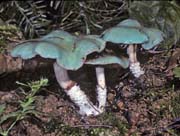
|
Stropharia aeruginosa
8b. Cap sky blue to greenish blue soon fading to pale olivaceous buff to yellowish-white, lacking floccose scales on margin, gills pale brown and remaining quite pale vinaceous tan with edges not fringed white. Veil remnants on stem forming a fragile ring of white floccose scales and scattered on stem surface below this. Microscopic: cheilocystidia are chrysocystidia.
Stropharia caerulea
9a. Cap with orange, red, or purple colours
9b. Cap coloured white, yellow to yellowish brown or brown, lacking distinct orange, red or purple.
10a. Cap with purple to wine red colours
10b. Cap orange to orange red or scarlet
| 11a. Large robust mushrooms, cap 5-20 cm. stem 7-15 cm. tall by 1-5 cm. thick, starting out with a non-viscid smooth purple-red, purple-brown or wine red cap that fades to tan or straw colour, annulus well developed and thick with large recurved claw like scales on underside, stem stout, at first white and smooth except for annulus, base enlarged and with white rhizomorphs. In wood chips, leaf mulch and mulched garden soils in cultivated areas. Cultured outdoors, spawn sold as "Garden Giant" or "Wine-red Stropharia". |
© Kit Scates Barnhart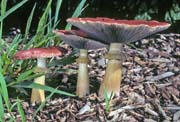
|
Stropharia rugoso-annulata
11b. Small slender mushrooms, cap 2-5 cm. stem 4-7.5 cm. tall by 3-4 mm thick, with slimy or viscid livid purple to drab purple brown radially wrinkled cap surface that fades in age to pale gray with purplish brown in center. Stem white, rather soft, equal in width and almost smooth with a fleeting thin white ring. Grows in lawns and other grassy areas. Rare.
Stropharia inuncta
| 12a. Small slender mushrooms, cap 1.5-5.5 cm. stem 3-7 cm. tall by 2-6 mm. thick, with slightly viscid to dry, scarlet to orange red cap that is often radially wrinkled around center and with slight white veil remnants on edge only. Gills sinuate to adnate, at first whitish soon gray or olivaceous gray to purple brown with pale edges. Stem smooth whitish to reddish or orange near base, rather soft fleshed and fragile, with faint fibrillose veil zone. In saw dust, wood shavings and mulched soils in landscaped areas of parks and gardens. Colour contrast between red cap and olivaceous to purple gray gills is striking. |
© Kit Scates Barnhart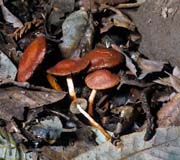
|
Stropharia aurantiaca
| 12b. More robust mushrooms, caps 3-8 cm. stem 6-15 cm. tall by 4-10 mm. thick cap viscid orange to red and with buff to tawny pointed scales scattered toward margin, stem with pointed or recurved orange buff to reddish brown scales below ring and darker brown toward base which often has coarse orange brown rhizomorphs, habitat in debris, duff and soil in high elevation and montane conifer forests. Also known as Psilocybe thrausta or P. squamosa var. thrausta based on lack of chrysocystidia. |
© John Plischke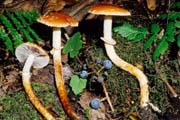
|
Stropharia squamosa var. thrausta
13a. Cap evenly coloured pale yellow to yellow buff or tan yellow, lacking streaking or spotting and blotching of other colours.
13b. Cap coloured otherwise or with any yellow present as spots or streaks.
| 14a. Small squat mushrooms in grassland, lawns, pasture and meadows, the height of stem equals or is less than cap width. Cap slightly viscid 2-5 cm. stem cylindric 2-5 cm. tall by 3-6 (10) mm. thick. Veil forms a thick collar annulus deeply radially grooved on the upper side. |
© Fred Stevens (MykoWeb).jpg)
|
Stropharia coronilla
| 14b. Tall rather large mushrooms, stem taller than cap is wide. Cap viscid 3-15 cm. stem 6-18 cm. tall by 5-20 mm wide, Cap margin festooned with white veil remnants, stipe with only faint and fleeting ring zone and white floccose scaly in lower part, tapering upward. Common under alder and maple in coastal mixed forests. |
© Steve Trudell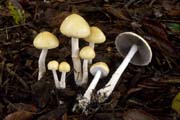
|
Stropharia ambigua
| 15a. Cap viscid, white at first becoming yellowish over the center unevenly, appearing spotted and blotched with ochraceous yellow sometimes with faint greenish yellow. Stipe is white to yellowish near base, white floccose scaly below well developed white membranous ring. Gills pale purple gray becoming blackish. In mixed woods with conifers and deciduous trees such as maple and alder. Rare. |
© Paul Kroeger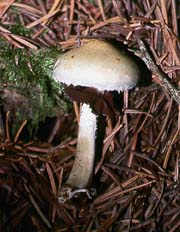
|
Stropharia albonitens
15b. Cap not white when young.
| 16a. Cap slightly viscid pale yellow with darker ochre yellow streaks and blotches over center, margin with scattered veil remnants, stem whitish to pale yellow becoming yellow ochre below, veil forms fibrillose to submembranous fragile ring, stem with scattered floccose scales and tapering downward. Gills pale yellowish white at first, becoming vinaceous brown. Under Alder Cottonwood and Aspen in riparian areas. |
© Michael Wood (MykoWeb).jpg)
|
Stropharia riparia
16b. Cap brown
| 17a. Veil remnants on both cap and stem pale brown or buff and forming pointed scales. Medium size mushrooms, cap 3-8 cm. wide stem 6-10 cm. long by 3-10 mm. thick, cap yellow-brown, light ochraceous brown or tawny to olive brown, conic to convex with scattered buff colour scales at first, stem brownish in lower portion with pointed or recurved pale brown scales, annulus membranous with pale striate upper surface and with brownish fibrillose patches underneath. In high elevation and montane forest with Alders and conifers. |
© Kit Scates Barnhart |
Stropharia squamosa
All material seen in BC has had the orange colouring of var. thrausta (see 12b.). Now known as Psilocybe squamosa due to lack of chrysocystidia.
17b. Veil remnants on stem pure white or whitish, caps bald or with faint cottony white scales only at edge, robust often quite large mushrooms
| 18a. Stem with white floccose scales over lower portion, gills pale gray at first soon becoming vinaceous gray to dark vinaceous gray or blackish, gill edges pale at first becoming concolorous. Robust mushrooms, cap 6-12 cm. stem 6-12 cm. long by 8-20 mm. thick, cap viscid to glutinous brown to faintly purplish brown bald or with white fine scales at edge, stem white becoming yellowish at base, with large floccose white scales below a thick edged floccose annulus. Growing on the ground, often in very decayed conifer wood common in high elevation and montane forests. Spores purple brown in deposit. Microscopic: Spores 11-13 μ long by 6-6.5 μ wide. |
© Steve Trudell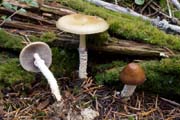
|
Stropharia hornemannii
| 18b. Stem smooth below with floccose scales just below ring, gills white at first becoming hazel brown and lacking distinct vinaceous gray colour, gill edges white fringed. Cap 4-8 cm. wide, stem 5-10 cm. long by 4-10 mm. thick, cap viscid to glutinous, pale vinaceous brown to brown without veil traces on edge, stem smooth below a large but thin and membranous annulus. Grows in conifer forests, on the ground in twiggy duff and humus. Rare. Spores brown in deposit. Microscopic: Spores 7-9 μ long by 4-5.5 μ wide. |
© Kit Scates Barnhart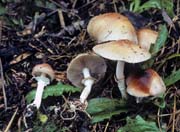
|
Stropharia albivelata
Previously known as Pholiota albivelata due to the brown spore colour. The presence of acanthocytes places it in Stropharia despite the uncharacteristic spore colour.
Breitenbach, J. and Kraenzlin, F. (1995). Fungi of Switzerland volume 4; Agarics, 2nd part. Edition Mykologia, Lucerne.
Farr, D.F. (1980). The acanthocyte, a unique cell type in Stropharia (Agaricales). Mycotaxon: 241-249.
Fine, J.L. (1972). The Stropharioidea of Western Washington. Unpublished Master of Science Thesis, Western Washington State College, Bellingham.
Guzmán, G. (1983). The genus Psilocybe. Beihefte Nova Hedwigia 74, Cramer, Vaduz.
Guzmán, G., and Kroeger, P. (2008). Psilocybe (Basidiomycotina, Agaricales, Strophariaceae) in Canada, with a special review of species from British Columbia. Mycotaxon 106: 179 – 193.
Guzmán, G. and Ott, J. (1976). Description and chemical analysis of a new species of hallucinogenic Psilocybe from the Pacific Northwest. Mycologia 68: 1261-1267.
Guzmán, G. and Smith, A.H. (1978). Three new species of Psilocybe from the Pacific-Northwest in North America. Mycotaxon 7: 515-520.
Hoiland, K. (1978). The genus Psilocybe in Norway. Botany 2: 111-122.
Horak, E. (1977). The genus Melanotus Pat. Persoonia 9:305-327.
Kühner, R. and Romagnesi, H. (1953). Flore Analytique des Champignons Superieurs. Masson, Paris.
Lincoff, G.H. (1981). The Audubon Society Field Guide to North American Mushrooms. Knopf, Inc. New York.
Moser, M. (1983). Keys to agarics and Boleti. Roger Phillips, London.
Noordeloos, M.E. (1998). Fungi non delineati IV; Pholiota, Psilocybe and Panaeolus. Mykoflora, Italia.
Noordeloos, M.E. (2001). Studies in Psilocybe sect. Psilocybe. Österr. Z. Pilzk 10: 115-180.
Norvell, L.L. & Redhead, S.A. (2000). Stropharia albivelata and its basionym Pholiota albivelata. Mycotaxon 76: 315-320.
Orton, P.D. (1969). Notes on British agarics II. Notes RBG Edinb. 29: 75-128.
Orton, P.D. (1984). Notes on British agarics VIII. Notes RBG Edinb. 41: 594-596..
Priest, M.J. and Simpson, J.A. (1992). Hypholoma tuberosum in Australia. The Mycologist 6: 11-12.
Redhead, S.A. (1981). Additional Agaricales on wetland Monocotyledoneae in Canada. Can. J. Bot. 62: 1844-1851.
Redhead, S.A. (1989). A biogeographical overview of the Canadian mushroom flora. Can. J. Bot. 67: 3003-3062.
Redhead, S.A. (1997). Macrofungi of British Columbia: requirements for inventory. British Columbia Ministry of Forests Research Program, Victoria.
Redhead, S.A. and Kroeger, P. (1984). Melanotus textilis, a new fabric-and wood-inhabiting North American agaric. Mycologia 76: 868-872.
Redhead, S.A. and Kroeger, P. (1988). A sclerotium-producing Hypholoma from British Columbia. Mycotaxon 29: 457-465.
Redhead, S.A. and Malloch, D. (1980). Melanotus caricicola. Fungi Canadensis 189.
Redhead, S.A. and Smith, A.H. (1986). Two new genera of agarics based on Psilocybe corneipes and Phaeocollybia perplexa. Can. J. Bot. 64: 643-647.
Sime, A.D. and Petersen, R.H. (1999) Intercontinental interrelationships among disjunct populations of Melanotus (Strophariaceae, Agaricales). Mycotaxon 71: 481-492.
Singer, R. (1986). The Agaricales in modern taxonomy. Koeltz, Koenigstein.
Singer, R. and Smith, A.H. (1958). Mycological investigations on Teonanácatl, the Mexican hallucinogenic mushroom II. A taxonomic monograph of Psilocybe, section Caerulescentes. Mycologia 50: 262-303.
Smith, A.H. (1937). Notes on Agarics from the Western United States. Bull. Torrey Bot. Club 64: 477-487.
Smith, A.H. (1938). New and unusual agarics from North America I. Mycologia 30: 20-41.
Smith, A.H. (1941). Studies of North American agarics I. Contr. Univ. Mich. Herb. 5: 63-66.
Smith, A.H. (1948). Studies in the dark-spored agarics. Mycologia 40: 669-707.
Smith, A.H. (1949). Mushrooms in their natural habitats. Hafner Press, New York.
Smith, A.H. (1951). The North American species of Naematoloma. Mycologia 43: 466-521.
Smith, A.H. (1975). A field guide to Western mushrooms. University of Michigan, Ann Arbor.
Smith, A.H. (1979). Stropharia riparia, a previously undescribed species suspected of occurring in Michigan. The Michigan Botanist 18:107-108.
Smith, A.H., Smith H.V. and Weber, N.S. (1979). How to know the gilled mushrooms. Wm. C. Brown Co. Dubuque, Iowa.
Smith, A.H. and Weber, N.S. (1980). The Mushroom Hunters Field Guide. University of Michigan, Ann Arbor.
Smith, A.H. and Hesler, L.R. (1946). New and unusual dark-spored Agarics from North America. J. Elisha Mitchell Sci. Soc. 62(2): 177-200.
Smith, A.H. and Hesler, L.R. (1968). The North American species of Pholiota. Lubrecht & Cramer NY.
Stamets, P. (1978). Psilocybe mushrooms and their allies. Homestead Book, Seattle.
Stamets, P. (1996). Psilocybin mushrooms of the world. Ten Speed Press, Berkeley.
Stamets, P., Beug, M.W., Bigwood, J.E. and Guzmán, G. (1980). A new species and a new variety of Psilocybe from North America. Mycotaxon 11: 476-484.
Stamets, P. (1995) A new caerulescent Psilocybe from the Pacific coast of Northwestern America. Integration 6: 21-28.
Watling, R. and Gregory, N.M. (1987). British Fungus Flora, Agarics and Boleti 5/ Strophariaceae & Coprinaceae p.p. Royal Botanic Garden, Edinburgh.
Key entry Code: H= Hypholoma, M= Melanotus, P= Psilocybe, S= Stropharia.
| Name and authority | key entry |
| Agaricus subrutilescens Kauffman | S 5a. |
| Hypholoma capnoides (Fr.: Fr.) Kummer | H 3a. |
| Hypholoma dispersum (Fr.) Quélet | H 3b. |
| Hypholoma elongatum (Pers.: Fr.) Ricken | H 6a. |
| Hypholoma ericaeoides Orton | H 7a. |
| Hypholoma ericaeum (Pers.: Fr.) Kühner | H 7b. |
| Hypholoma fasciculare (Huds.: Fr.) Kummer | H 2a. |
| Hypholoma myosotis (Fr.: Fr.) M.Lange | H 5a. |
| Hypholoma subericaeum (Fr.) Kühner | H 7b. |
| Hypholoma tuberosum Redhead & Kroeger | H 4a. |
| Hypholoma udum (Pers.: Fr.) Kühner | H 6a. |
| Melanotus caricicola Orton | M 2a. |
| Melanotus horizontalis (Bulliard) Orton | M 1b. |
| Melanotus phillipsii (Berk. & Br.) Singer | M 2b. |
| Melanotus textilis Redhead & Kroeger | M 1b. |
| Mythicomyces corneipes (Fr.) Redhead & Smith | P 15a. |
| Pholiota albivelata Murrill | S 18b. |
| Pholiota myosotis (Fr.) Singer | H 5a. |
| Pholiota subcaerulea A.H.Smith & Hesler | S 7a. |
| Psilocybe angustispora Smith in Smith & Hesler | P 11a. |
| Psilocybe apelliculosa Orton | P 19a. |
| Psilocybe atrobrunnea (Lasch) Gillet | P 18b. |
| Psilocybe azurescens Stamets & Gartz | P 8a. |
| Psilocybe baeocystis Singer & Smith | P 9a. |
| Psilocybe caespitosa Murrill | P 24b. |
| Psilocybe callosa (Fr.: Fr.) Quélet | P 7b. |
| Psilocybe coprophila (Bulliard: Fr.) Kummer | P 13a. |
| Psilocybe corneipes (Fr.) Karsten | P 15a. |
| Psilocybe crobula (Fr.) M.Lange | P 24a. |
| Psilocybe cyanescens Wakefield | P 8a. |
| Psilocybe cyanofibrillosa Guzmán & Stamets | P 9b. |
| Psilocybe fimetaria (Orton) Watling | P 3a. |
| Psilocybe inquilina (Fr.: Fr.) Bresadola | P 22b. |
| Psilocybe luteonitens (Vahl.: Fr.) Parker-Rhodes | S 3b. |
| Psilocybe merdaria (Fr.) Ricken | P 14a. |
| Psilocybe moellerii Guzmán | P 14b. |
| Psilocybe montana (Pers.: Fr.) Kummer | P 18a. |
| Psilocybe pelliculosa (Smith) Singer & Smith | P 5a. |
| Psilocybe phyllogena (Peck) Peck | P 23b. |
| Psilocybe physaloides (Bull. ex Merat) Quél. | P 24b. |
| Psilocybe rhombispora (Britz.) Sacc. | P 23b. |
| Psilocybe sabulosa Peck | P 16a. |
| Psilocybe semilanceata (Fr.) Kummer | P 6a. |
| Psilocybe sp. Meager Cr. #1 PK1196, 1240, 1241, 1248. | P 20a. |
| Psilocybe sp. Meager Cr. #2 PK1173 & 1190. | P 25b. |
| Psilocybe squamosa (Pers.: Fr.) Orton | S 17a. |
| Psilocybe strictipes Singer & Smith | P 7b. |
| Psilocybe stuntzii Guzmán & J. Ott | P 3b. |
| Psilocybe subcoprophila (Britz.) Saccardo | P 13b. |
| Psilocybe subfimetaria Guzmán & Smith | P 7a. |
| Psilocybe subviscida (Peck) Kauffman | P 25a. |
| Psilocybe thrausta (Schulz.ex Kalchbr) Bon | S 12b. |
| Stagnicola perplexa (Orton) Redhead & Smith | P 15a. |
| Stropharia aeruginosa (Curtis) Quélet | S 8a. |
| Stropharia albivelata (Murrill) Norvell & Redhead | S18b. |
| Stropharia albocyanea (Desm.) Quél. | S 7a. |
| Stropharia albonitens (Fr.) Karsten | S 15a. |
| Stropharia ambigua (Peck) Zeller | S 14b. |
| Stropharia aurantiaca (Cooke) Orton | S 12a. |
| Stropharia caerulea Kriesel | S 8b |
| Stropharia coronilla (Bulliard: Fr.) Quélet | S 14a. |
| Stropharia hornemannii (Fr.: Fr.) Lund. & Nannf. | S 18a. |
| Stropharia inuncta (Fr.) Quélet | S 11b. |
| Stropharia kauffmanii Smith | S 5a. |
| Stropharia luteonitens (Vahl.: Fr.) Quélet | S 3b. |
| Stropharia pseudocyanea (Desm. ex Fr.) Redhead | S 7a. |
| Stropharia riparia Smith | S 16a. |
| Stropharia rugoso-annulata Farlow ex Murrill | S 11a. |
| Stropharia semiglobata (Batsch: Fr.) Quélet | S 3a. |
| Stropharia semigloboides Murrill | S 4a. |
| Stropharia silvatica Smith | S 4b. |
| Stropharia squamosa (Pers.: Fr.) Quélet | S 17a. |
| Stropharia squamosa var. thrausta (Schulzer ex Kalchbr.) Massee | S 12b. |
| Stropharia umbonatescens (Peck) Saccardo | S 3b. |
| Psilocybe laticystis Guzmán & Smith | recent collection from Lyell Island BC needs confirmation |
| Psilocybe liniformans Guzmán & Bas | not known from BC |
| Psilocybe subborealis Guzmán & Smith | not known from BC |
| Psilocybe washingtonensis Smith | not known from BC |
| Stropharia alcis Kytöv. | several suspected collections from BC need confirmation |
- END -